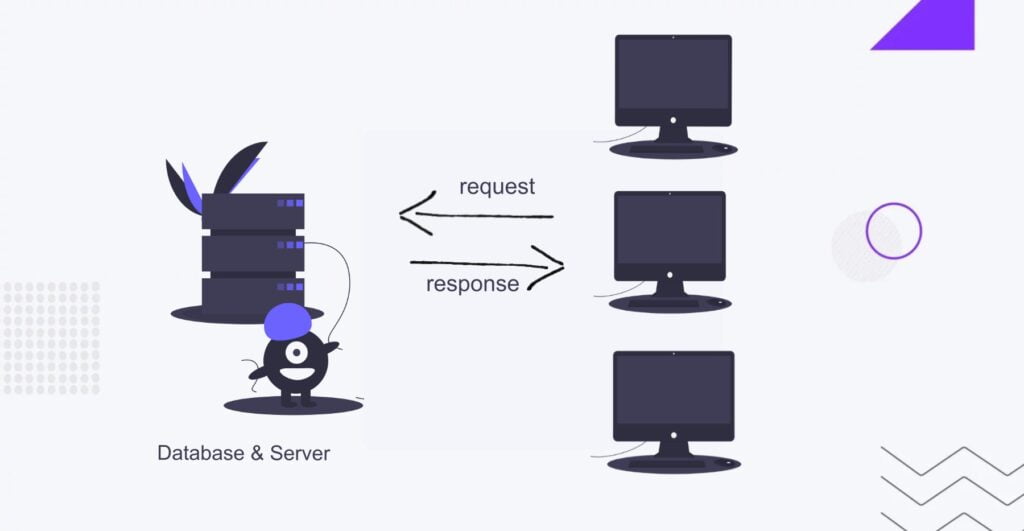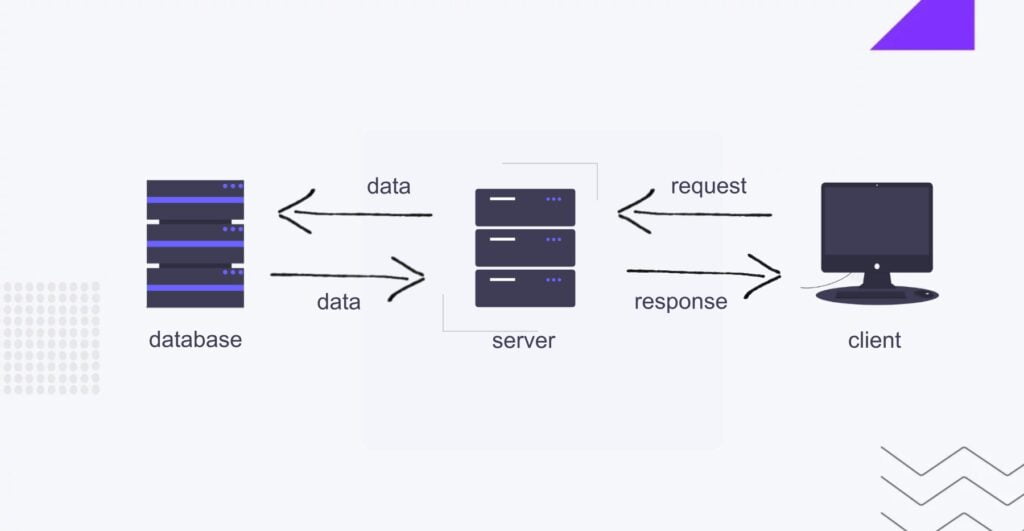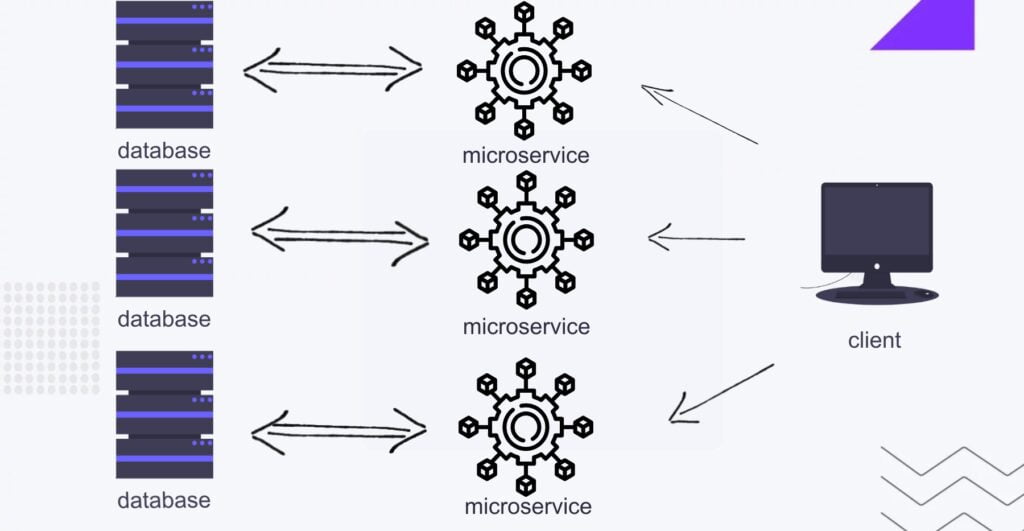Ecommerce Website Architecture
Table of Contents

Ecommerce website architecture is the structural design of an online store, encompassing its layout, functionality, and how it interacts with users and systems. Selecting the appropriate ecommerce architecture can significantly impact your business’s success. The right architecture can enhance performancePerformanceRefers to how fast a website or web application loads and responds to user interactions.
More About Performance, scalability, and maintainability while ensuring a superior user experience. Conversely, a poor choice can lead to operational inefficiencies, increased costs, and hindered growth. This guide provides an in-depth review of different ecommerce website architectures and their key components and offers tips on choosing the right one for your business.
What is ecommerce website architecture?
Ecommerce website architecture is the structural framework defining how an online store is built and operates. It includes the organization of various components, such as the user interface, applicationApplicationA software program designed to perform specific functions or tasks on electronic devices, such as smartphones and tablets, computers, and smart TVs.
More About Application logic, and data management, and their interactions. A robust ecommerce website architecture ensures that the ecommerce platform is scalable, secure, and capable of providing a seamless shopping experience.
What Are the Key Components of Ecommerce Architecture?
The key components of a modern ecommerce architecture include:
- The Client Tier, or the front-end WordPress, is where users interact with the website. This tier comprises all user interface elements, including web pagesWeb PagesHTML documents accessed via the internet.
More About Web Pages, mobile apps, and other user-facing components. - The Server Tier, or ecommerce backendBackendThe server-side of an application responsible for managing data, business logic, and interacting with databases.
More About Backend architecture, processes the core business logic and handles transactions. It includes web servers, application servers, and other components that manage data processing and communication with the databaseDatabaseAn organized collection of data, typically stored electronically.
More About Database. - The Database Tier manages data storage and retrieval. This includes relational databases, NoSQL databases, and data warehouses that store product information, user data, order details, and more.
- The Application Layer contains the ecommerce platform’s core business logic. It includes components that manage product catalog management, shopping cart operations, order processing, and payment gateways.
- The Service Layer provides reusable services that other components can use, such as payment processing, email notifications, and third-party API for ecommmerce website integrations.
- The Integration Layer manages communication between the ecommerce platform and external systems or services, such as payment gateways, shipping providers, and third-party applications.
- The Caching Layer stores frequently accessed data temporarily to improve performance and reduce load on the backend servers and databases.
Seeking expert ecommerce help?
Popular Ecommerce Website Architectures
When designing an ecommerce platform, selecting an architecture that aligns with your business needs and technical capabilities is essential. This is not an exhaustive list of all possible architectures, but it covers the most common ones suitable for many e-commerce businesses and needs.
Ecommerce website architecture diagram and ecommerce microservices architecture diagram can help visualize the different components and their interactions within the architecture, making it easier to understand and implement the chosen structure.
2-Tier Architecture

The 2-tier architecture consists of the Client Tier and the Server Tier. The Client Tier is the website’s front endFront EndThe visible interface visitors engage with upon visiting a website constitutes its front end.
More About Front End, where users interact directly. The Server Tier handles the business logic and database interactions, processing user requests and managing data.
Pros:
- Simplicity: The 2-tier architecture is straightforward to implement and manage, making it an excellent choice for small businesses or simple applications.
- Lower Cost: This architecture typically incurs lower development and maintenance costs because of its simplicity.
Cons:
- Limited Scalability: As the user base grows, the single server can become a bottleneck, limiting the ability to scale efficiently.
- Performance Issues: High trafficTrafficThe number of visitors or users who visit a particular website.
More About Traffic can strain the server, leading to performance degradation.
3-Tier Architecture

3-tier architecture divides the system into three distinct layers: the Presentation Tier, the Application Tier (Logic Tier), and the Data Tier. The Presentation Tier is the user interface, the Application Tier handles the business logic, and the Data Tier manages the database operations.
Pros:
- Better Scalability: Each tier can be scaled independently, allowing the system to handle increased load more efficiently.
- Maintainability: Separating concerns makes updating and maintaining each layer easier without affecting the others.
Cons:
- Increased Complexity: Dividing the system into three layers requires more careful planning and coordination, which can increase development time and costs.
- Potential Performance Bottlenecks: Interactions between layers can introduce latency, affecting overall performance if not managed properly.
Multi-Tier (N-Tier) Architecture
Multi-tier architecture extends beyond the traditional 3-tier model by adding additional layers such as the Service, Integration, and CacheCacheA temporary storage location that stores frequently accessed data to reduce load times.
More About Cache Tiers. Each layer serves a specific function, further separating concerns and improving the system’s scalability and flexibility.
Pros:
- High Scalability: Multi-tier architecture’s modular nature allows for high scalability, accommodating large user bases and complex operations.
- Fault Tolerance: By isolating different functions into separate layers, the system can better handle failures in one part without affecting the entire platform.
Cons:
- Higher Complexity: The additional layers add to the system’s complexity, requiring advanced technical expertise for design, implementation, and maintenance.
- Increased Cost: Developing and maintaining a multi-tier architecture can be more expensive due to its complexity and the need for specialized skills.
Need to optimize store’s architecture?
Monolithic Architecture
The monolithic architecture integrates all the ecommerce platform’s components into a single codebase. The user interface, business logic, and data access layers are tightly coupled and interdependent. All functionalities are contained within one large application deployed as a single unit.
Pros:
- Simplifies Development and DeploymentDeploymentThe process of releasing and installing software applications, updates, or new features onto a production environment.
More About Deployment: With everything in one place, development is more straightforward, and deploying the application is simpler since you only need to manage a single deployment process. - Easier to Test and Debug: Debugging and testing are more manageable because all components are contained within one application, making it easier to trace issues and understand the system.
Cons:
- Challenges in Scalability: As the application grows, scaling becomes difficult because you need to scale the entire application rather than individual components.
- Maintenance Issues: Over time, the codebase can become large and unwieldy, making it harder to manage, update, and add new features without affecting existing functionalities.
- Limited Flexibility: Changes to one part of the application can impact the entire system, making it less flexible and more prone to errors.
Microservices Architecture

Ecommerce microservices architecture breaks down the ecommerce platform into independent, loosely coupled services, each responsible for specific functionality (e.g., user management, product catalog, order processing). These services communicate with each other through APIs.
Pros:
- High Scalability: Each service can be developed, deployed, and scaled independently, allowing for more efficient use of resources and better performance under high load.
- Flexibility: Developers can use different technologies and programming languages for different services, optimizing each service for its specific function.
- Resilience: If one service fails, it does not harm the entire system, enhancing the platform’s overall reliability.
Cons:
- Complexity in Managing Distributed Systems: Managing multiple services requires sophisticated orchestration and monitoring tools, increasing the system’s complexity.
- Communication Overhead: Services must communicate over the network, which can introduce latency and require careful management to ensure efficiency and reliability.
- Data Consistency: Ensuring data consistency across services can be challenging, requiring additional effort in design and implementation.
Seeking a custom plan?
Serverless Architecture
Serverless architecture leverages cloud services to manage server infrastructure, allowing developers to focus solely on writing code. In this model, the cloud provider automatically handles the allocation and management of server resources, scaling them as needed.
Pros:
- Reduced Operational Costs: Operational costs are lower since the cloud provider manages the infrastructure. You only pay for the computing resources you use.
- Automatic Scaling: The cloud provider automatically scales resources up or down based on demand, ensuring the platform can handle varying levels of traffic without manual intervention.
- Faster Time to Market: Developers can focus on coding without worrying about server management, leading to faster development cycles and quicker deployment of new features.
Cons:
- Potential Vendor Lock-In: Relying on a specific cloud provider’s services can make it difficult to switch providers in the future, potentially limiting flexibility and increasing dependency.
- Limited Control Over Infrastructure: While serverless architecture abstracts away server management, you have less control over the infrastructure, which can be a drawback for applications with specific performance or configuration requirements.
- Cold Start Latency: Serverless functions may experience latency during cold starts, when functions are invoked after being idle, leading to slower response times for some requests.
Event-Driven Architecture
Event-driven architecture is a design paradigm where components communicate by producing and consuming events. Events are state changes or significant actions within the system, such as a user placing an order or adding a product to the catalog. Components or services, listen for these events and reactReactA JavaScript library developed by Facebook for building user interfaces, particularly for single-page applications, by creating reusable UI components.
More About React accordingly. This architecture is highly asynchronous, allowing for more responsive and scalable systems.
Pros:
- Highly Decoupled: Components are loosely coupled, making the system more modular and easier to modify or expand without affecting other parts.
- Responsive: The system can react quickly to real-time events, providing a more dynamic user experience.
- Scalability: It is easier to scale individual components based on demand, as each component operates independently.
Cons:
- Complexity in Managing Events: Tracking and managing the flow of events can become complex, especially in large systems with many interacting components.
- Debugging Challenges: Debugging issues in an event-driven system can be difficult because of the asynchronous nature and the potential for events to be processed out of order.
Service-Oriented Architecture (SOA)
Service-oriented architecture (SOA) is a design approach where larger, more coarse-grained services provide functionality to other services or applications through defined interfaces. Each service encapsulates a specific business process or function and communicates over a network using standard protocols.
Pros:
- Reusability: Services can be reused across different applications, reducing redundancy and development effort.
- Scalability: Services can be scaled independently to meet varying demands, improving overall system performance.
- Interoperability: Standardized interfaces and protocols enable seamless integration with other services and systems.
Cons:
- Potential Performance Bottlenecks: The need for service orchestration and communication can introduce latency and impact performance.
- Complexity in Management: Managing multiple services and ensuring their coordination can be complex, requiring robust governance and monitoring.
Layered (N-Layer) Architecture
Layered architecture, also known as N-layer architecture, is an ecommerce website structure that organizes the system into logical layers, each responsible for specific aspects of the application. Common layers include the presentation layer (user interface), business logic layer (application logic), and data access layer (database interactions).
Pros:
- Clear Separation of Concerns: Each layer handles distinct responsibilities, making the system more organized and easier to maintain.
- Flexibility in Development: Developers can work on different layers independently, speeding up development and simplifying testing.
- Enhanced Maintainability: Changes in one layer can be made without impacting other layers, making updates and bugBugAn error, flaw, or glitch in a software program or system that causes it to behave unexpectedly or produce incorrect results.
More About Bug fixes more manageable.
Cons:
- Performance Overhead: The multiple layers can introduce latency, as data must pass through each layer.
- Complexity in Data Handling: Ensuring efficient data flow between layers requires careful design and can complicate the architecture.
Headless Commerce
Headless commerce decouples the front end (presentation layer) from the back end (business logic and data layer), allowing greater flexibility in delivering user experiences. The front end communicates with the backend via APIs, enabling developers to use different technologies and frameworksFrameworksA pre-established structure or set of guidelines that provides developers with a foundation to build upon.
More About Frameworks for the user interface.
Pros:
- Flexibility in Presentation Layers: Developers can create custom-built sites and tailored user experiences using the best front-end tools and frameworks.
- Faster Updates: Decoupling allows for independent updates of the front end and back end, enabling quicker deployment of new features and fixes.
- Omnichannel Experience: The same backend can serve multiple frontends, providing a consistent experience across web, mobile, and other platforms.
Cons:
- Complexity in Integration: To ensure seamless operation, managing and integrating separate systems requires robust APIs and careful coordination.
- Increased Development Effort: Building and maintaining two separate systems (frontend and backend) can require more development resources and expertise.
Choosing the Right Architecture for Your Ecommerce Business
Choosing the right commerce architecture is a critical decision that can significantly impact your platform’s performance, scalability, and overall success. Several factors should be considered when selecting the most suitable architecture for your ecommerce needs:
- The size of your business plays a crucial role in determining the appropriate architecture. Small companies benefit from simpler architectures that are easy to manage and cost-effective. In contrast, larger enterprise website development may require more complex, scalable solutions to handle higher traffic and more extensive operations.
- Scalability is essential for accommodating growth. If you anticipate rapid growth or seasonal spikes in traffic, you’ll need an ecommerce site architecture that can scale efficiently. Architectures like microservices and multi-tier are designed to handle high scalability, whereas simpler architectures like 2-tier might struggle under heavy loads.
- Budget constraints can influence your choice of architecture. Simpler architectures, such as 2-tier or monolithic, are generally less expensive to implement and maintain. However, investing in a more complex architecture like microservices or serverless may provide long-term cost benefits through improved performance and scalability.
- Another critical factor is the level of technical expertise available on your team. Some architectures, like monolithic or 2-tier, are easier to develop and maintain with limited technical skills. In contrast, microservices, serverless, or multi-tier architectures require advanced knowledge and experience to manage effectively.
Need help with ecommerce architectures?
Examples of Suitable Architectures for Different Business Types
Different business types have varying requirements, and choosing the right architecture can ensure optimal performance and growth.
Small Businesses:
- 2-Tier Architecture: This architecture is ideal for startups and small businesses due to its simplicity and cost-effectiveness. It provides the necessary functionality without the complexity and cost of more advanced architectures.
- Monolithic Architecture: Suitable for small teams with limited technical expertise. It simplifies development and deployment, allowing for quicker time-to-market.
Medium to Large Enterprises:
- 3-Tier Architecture: Provides better scalability and maintainability, making it suitable for medium-sized businesses that need a robust and scalable solution.
- Microservices Architecture: Ideal for large enterprises that require high scalability and flexibility. Each service can be developed, deployed, and scaled independently, allowing for greater agility and resilience.
High-Growth Companies:
- Multi-Tier (N-Tier) Architecture: This architecture suits businesses anticipating rapid growth. It offers high scalability and fault tolerance, accommodating increasing traffic and complex operations.
- Serverless Architecture is excellent for companies looking to minimize operational overhead and benefit from automatic scaling. It reduces the need for server management and can handle fluctuating traffic efficiently.
- Headless Commerce is ideal for businesses prioritizing delivering a flexible and innovative user experience. It decouples the front end from the backend, allowing for greater customization and faster updates.
Conclusion
Choosing the right ecommerce website architecture is the best way to build an ecommerce website. Your chosen architecture will impact your platform’s performance, scalability, maintainability, and overall user experience. By considering factors such as business size, scalability needs, budget, and technical expertise, you can make an informed decision that aligns with your business goals.
Investing time and resources into selecting the right architecture will pay off in the long run, ensuring your ecommerce platform is robust, scalable, and capable of providing an exceptional user experience. However, if you are looking for fast and efficient results, it’s better to rely on professional help. At IT Monks, we are experts in building usable and results-oriented ecommerce websites. We take care of everything – from planning to execution, ensuring the final result fully meets your request. Contact us to discuss your project’s details!



